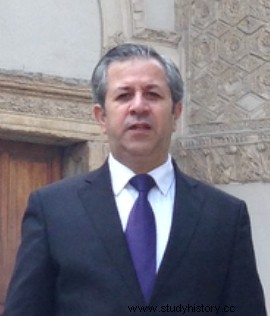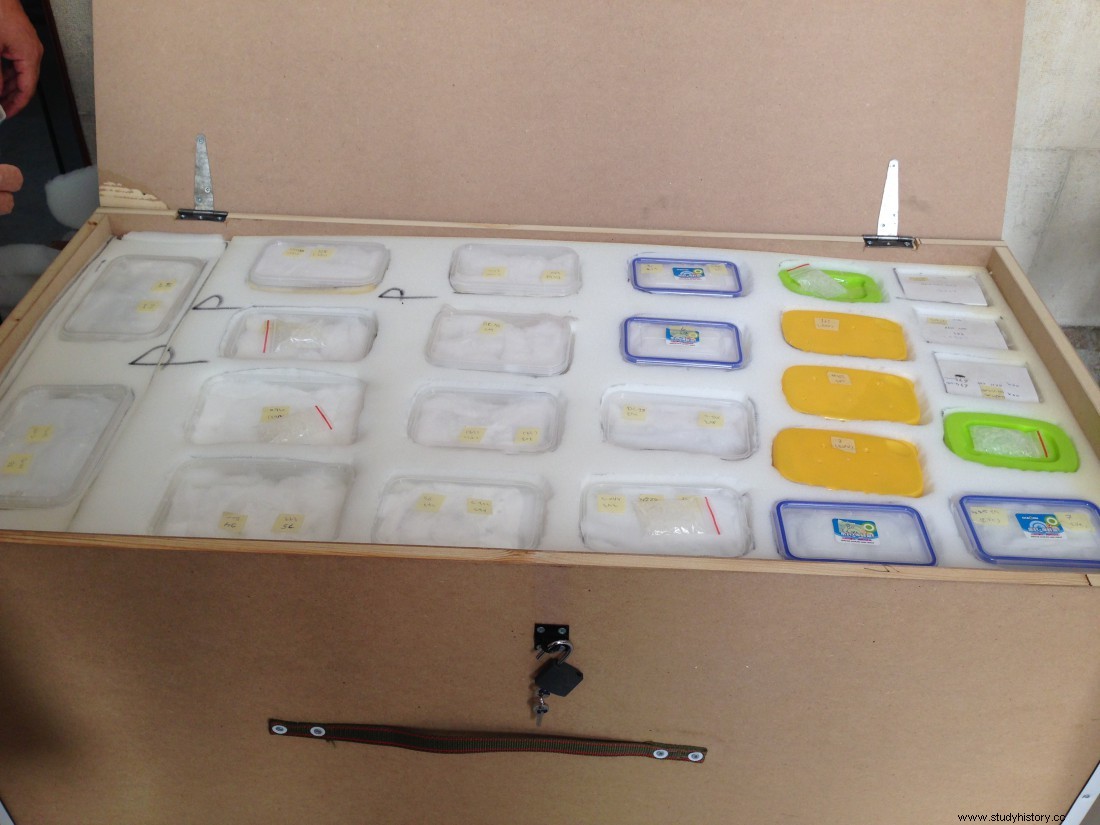 In Damascus, archaeologists urgently pack the repatriated antiquities from all the museums in Syria to put them in safe places.
In Damascus, archaeologists urgently pack the repatriated antiquities from all the museums in Syria to put them in safe places. While France has just launched its first air strikes in eastern Syria against Daesh* elements, in Damascus archaeologists are in a race against time to identify, photograph and protect tens of thousands of objects of ancient Syrian heritage brought back to the capital at the cost of a thousand dangers. Reached by telephone from Damascus, Dr. Maamoun Abdulkarim, Director General of Antiquities and Museums of Syria, draws up an exclusive inventory for Sciences et Avenir.
Sciences et Avenir:Since the tragic events in Palmyra, what is the situation of Syrian heritage?
Maamoun Abdulkarim:In order not to see a repeat of what happened at the museum in Baghdad (Iraq) in 2003, we had begun to repatriate thousands of antiquities to Damascus even before the destruction of the temples of Baalshamin and Bel in Palmyra. To date, more than 300,000 Syrian heritage objects – 99% of Syrian antiquities collections – have been saved in this way! All objects are documented and photographed before being put in safe places (see photo below ). Including the 400 statues that were in Palmyra and that we were able to transfer just before the fall of the city or even the 30,000 objects that were in the museum of Deir ezzor, a city located in the east of the country, currently in the hands of Daesh *. Only Idleb remains, in the north, where 15,000 objects are still protected by the local population.
Who are the people involved in these rescues?
 The 2,500 civil servants of the Directorate General of Syrian Antiquities. That is to say hundreds of archaeologists, engineers, architects, technicians, or guards. It is thanks to them that our heritage is being saved. Some even continue to work in areas that are not under government control, with all the risks involved.
The 2,500 civil servants of the Directorate General of Syrian Antiquities. That is to say hundreds of archaeologists, engineers, architects, technicians, or guards. It is thanks to them that our heritage is being saved. Some even continue to work in areas that are not under government control, with all the risks involved.
What do you know about looting by Daesh and others?
The looters come directly with bulldozers to ravage the archaeological sites to extract the objects and statues. For us archaeologists, these sites are permanently lost, because the context in which these elements were located disappears! This is what happened at the site of Mari (Tell Hariri), in the south of the country.
According to Unesco and various international institutions, the channels of archaeological looting are used to partly finance terrorism. Where are stolen items sent?
Whether in areas controlled by Daesh or Jabhat al-Nusra, another extremist group, the traffickers come from neighboring countries. When looting takes place in northern Syria, potential buyers come from Turkey or Israel. If they took place in the region of Apamea, in the west, they come from Lebanon or from Jordan for the South, etc.
When was the first looting attributable to terrorist groups?
The first alerts reached us at the beginning of 2013:looters were already coming to locate the most important archaeological sites and the furthest from the cities under government control. On June 4, 2013, we officially requested the international strengthening of border controls. Unfortunately, no one listened to us, apart from Unesco*, Icom* and Icomos* who have continued to support us.

Before they are stored in caches, all antiquities that reach Damascus are documented and photographed. © Maamoun Abdulkarim.
How do you explain the campaign to eradicate heritage sites by Daesh which destroys on one side and resells on the other. Isn't it paradoxical?
The looting is carried out in parallel with the destruction of an ideological nature. The jihadist organization destroys the statues which it says are pagan objects. But cultural goods are not just statues! This concerns mosaics, figurines, coins, ceramics, cuneiform tablets, gold ornaments, ivory objects, etc. And it is the money from the sale of these treasures that is reinvested in the financing of the terrorist group.
When did you notice a change in international bodies?
This very clearly happened after July 2014, when the first satellite images were published showing the devastation suffered by the site of Apamea, a site from the Hellenistic, Roman and Byzantine period. There was then a global awareness. Since then, initiatives have not stopped. Unesco also plays a crucial role, in particular its director Irina Bokova who tirelessly mobilizes States in the face of the destruction and abuses that have taken place in Syria, where unfortunately, nearly 300 archaeological sites have already been affected.
Which countries does the Directorate of Syrian Antiquities receive assistance from?
I must say that France and its researchers are at the forefront of the major partner countries that have always helped Syrian heritage, even if the French government officially has no contact with Syria. We must also mention Germany, Italy, Great Britain and Japan as well as the World Monument Fund, a non-governmental organization based in the United States. Other countries are also providing cooperation, such as Spain, Denmark and Holland.
Given the complexity of the situation, the chaos, but also the acceleration of events, what would you like to say?
We have always refused a political use of the heritage issue:We must save Syrian heritage as such! Politics change, people change, heritage remains. It is the memory of a people, its identity. What matters today is how we can all work together to get out of this situation. The fact of having succeeded in sheltering entire collections of museums in Syria is the most important. Of course, our life is very difficult, we feel the threat:to go 15 km from Damascus is already taking risks. Every day, we learn of the murder of colleagues, the destruction of their homes or those of their parents. But we made the choice to stay. We continue this fight to save the soul of a people. We must defend Damascus because if we lose Damascus, we will lose the whole history of Syria! If we say that Syrian heritage is world heritage, then the world must not abandon us. This heritage is also yours!
"We seized at the borders 6500 items looted"
A lot of information, often contradictory, has been disseminated concerning the controls carried out at the borders of Syria. For the first time, Dr. Maamoun Abdulkarim, Director General of Antiquities and Museums of Syria, gives a quantified assessment.
"I saw a few controversies arise here and there aimed at saying that we could not find objects from looting in Syria on European markets. And that's normal! Many checks are now carried out by the Syrian police and customs at the borders, whether to Europe, the United States or China. Lebanon is also the only neighboring country that really cooperates with us by also carrying out checks and giving us back the intercepted objects. On the Syrian side, we were also able to recover 6500 objects, among which fakes had been slipped! We especially got our hands on an important monetary treasure of 1600 coins dating from the time of Queen Zenobia (3rd century A.D.). But we know that those in charge of mafia networks are hiding their loot today, waiting for better days! In 10 or 15 years, these looted objects will gradually reappear."
Glossary : UNESCO :United Nations Educational, Scientific and Cultural Organization . . . . . . . . . . . . . :International Council of Museums (has established an Emergency Red List of Syrian Cultural Objects at Risk). Icomos :International Council on Monuments and Sites
*Daesh:name of the Islamic State in Arabic language.
